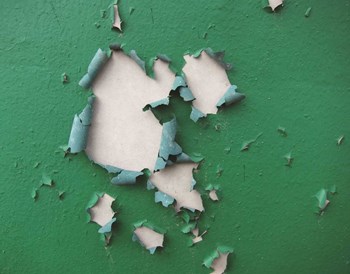
Hazardous materials can haunt any property. While lead paint is considered a potential problem only in structures built before 1978, contemporary projects can be dogged with the discovery of radon in the interior air or water. And brand-new residential communities have been constructed in recent years on reclaimed hazardous materials (“haz-mat”) sites, just as abandoned industrial buildings have been reclaimed to be converted into trendy lofts and condos.
A most-pervasive, potential problem for New England properties may be radon, which is a radioactive, colorless, odorless, tasteless gas, occurring naturally underground in a wide range of materials from granite to limestone. As an indirect decay product of uranium or thorium, radon is considered a health hazard due to its radioactivity. The federal Environmental Protection Agency (EPA) recommends that the average radon exposure rate indoors not exceed 4.0 picocuries per liter (pCi/L). All six New England states test positive for radon, in concentrations that vary widely by location.
Tom Hilditch, CPM, a property manager with Dannin Management in Brookline, Massachusetts, has had experience with radon. “We had a Boston-area property where the issue of radon cropped up and got the association involved. This can come up when there’s a unit being sold, if radon is part of the inspection process. In this case, it was a mid-rise, very high-end building with about 50 units in a variety of floor-plan layouts. A buyer was interested in a unit and in the inspection process, they discovered radon in the storage room, which is at ground level, immediately under the unit for sale. They had set up a device for a few days to get the radon reading. This building’s ground level sits on ledge rock. With this report from the inspector, the buyer insisted that some remediation tale place.”
As it turned out, there was no quick fix, Hilditch explains, “We had to run a 3” pipe from the base-level storage room up the stairwell; drilling cores through the concrete slab of each landing… for seven stories. The pipe was designed to draw from a vent installed in the storage-room wall at floor level… it ran up to roof level, where a fan was put in to pull the air up. It was several thousand dollars for the association—that was not a planned expense.”
Compounding the problem of hazardous materials lurking in residential structures are materials that were once considered ordinary—and “safe”—but are now highly regulated as potential health hazards. Hilditch has been involved with heating-oil spills, which can set off a domino effect of destruction. He relates, “One building we were involved with was an urban high-rise, built in the 1960s, and one day, the oil delivery truck accidentally kept pumping after the tank was full. It left two inches of oil [in a basement storage area] and everything that it touched is considered ‘haz-mat’ and has to be accounted for. We had to call in Clean Harbors, since they specialize in environmental clean-up. Even after they were done, the association still had to deal with a smell.”
Even New Construction Suspect
Ted Salgado is principal owner of Reserve Advisors, which has an office in Hartford, Connecticut. He points out that “increasingly, residential construction of multi-unit communities is done on reclaimed land. Even a major haz-mat site may be cleaned up and pollutants mitigated, and approved for new construction. We had a client association in the Midwest where the condo project was built on top of an old coal storage area. Even though the site was capped off, it was never completely remediated. Oftentimes, the developers who build new, residential communities don’t have expertise in environmental issues.”
He explains that municipalities are often eager to “infill” abandoned industrial sites and brownfields and create affordable housing, adding, “A redevelopment authority, working for a city, can get away with more [in side-stepping regulations]” than a private developer. “In a similar case, about six years ago, a riverfront property, site of a former tannery, was ‘reclaimed’ with construction of about 100 condo units.”
Problems may be revealed, he notes, “when a savvy buyer will ask to do testing beyond just the unit inspection—which is the basic threshold. For anyone who is concerned, we advise: Look for disclosures that run with the property. Something like ‘coalfield’ is a disclosure that’s attached to the property title. Potential buyers should make their offers contingent on seeing all these documents. Plus, for added disclosure, it’s wise to look at an association’s annual meeting minutes, for a year or more going back. This will reveal any [environmental] problems that occurred in common areas.”
While harmful gases may seep up from tainted ground into brand-new housing units, a different recurring problem Salgado sees with new construction “is that they’re built a lot tighter, and there’s little air exchange. That’s when you get ‘sick building syndrome’ with lingering vapors and fumes from carpets, paints, vinyl and adhesives.”
Glenn Potter is the director of the building sciences group at Covino Environmental Associates in Woburn, Massachusetts. His firm does testing for hazardous materials, from PCBs in caulking material to radon, asbestos, mercury and lead paint—and post-testing, they also oversee the abatement process. He confirms that testing and any resulting remediation is often done as “a due-diligence process, when someone is considering purchase of a property.”
The problem with radon, he agrees, is greater within residential structures “which are built to be a lot tighter than commercial spaces, which typically have more air circulation. The measurement of radon can vary from room to room, going above or below the acceptable threshold.” Potter recommends that “any condo conversion should include testing for radon, so mitigation can be built into the design” when it’s much more simple and cost-effective.
‘Miracle Mineral’ is Now a Hazard
One of the most popular and useful construction materials of the 20th century has turned out to be the bane of building owners everywhere. Asbestos, which is composed of a set of silicate [glass] minerals that occur in long, thin crystals, was known as the “miracle mineral.” Potter points out that asbestos is downright ubiquitous in buildings constructed or renovated from the late 1950s into the 1970s. “Its fibers are very strong, and it provides thermal and acoustical insulation, as well as electrical insulation, since it is not very conductive,” Potter states. “It is, however, a known human carcinogen.” It is harmless if undisturbed but becomes a health threat when the crystal particulate becomes airborne and people inhale it.
Contractors often run into asbestos in unexpected places during remodeling or repairs. “We had a upscale property where some pipes ran inside the ceiling soffit, in a top-floor unit,” Potter relates. “The pipes needed repair and the contractor opened up the ceiling to get at the pipes. The ceiling surface had been sprayed with a texture paint, and cutting through it, they had created a lot of dust. The unit owner was in the process of moving in and she had a lot of expensive stuff, including thousands of dollars of designer clothes, in that space. She was concerned about the dust and called the local health department, and they called in the [state] DEP (Department of Environmental Protection), who called us in to test the dust. The texture paint in this particular unit contained asbestos, but it was only this unit… Other top-floor units [which were subject to the pipe repair] didn’t have the same ceiling paint.”
“The insurance company for the association,” he continues, “had to hire an appraiser for the high-end women’s clothes… it was a most expensive loss.” Everything the dust touched was treated as hazardous material. “Since then,” he says, “the association requires any contractor to bring in a certified inspector to do testing before they approve any renovations.”
He notes that asbestos can be in any building material, including ceiling or floor tiles or joint compound. In the effort to protect workers, he says, “OSHA presumes a potential asbestos hazard in any building older than 1980. It may be in floor tile or insulation, or spray-applied… You should presume it’s there, or do testing to see if it’s there.”
Describing the process, Potter says, “Our team will go into a building, and visually assess for suspected asbestos in the ceiling finish or ceiling tile, for instance. We take samples from the ceiling, walls, tiles, and caulk, looking for various hazardous materials. For example, for lead paint, we have a device that reads [the composition of] paint surfaces, even multiple layers.”
Asbestos is still in use today, he points out, but only “in products where it is non-friable [can’t be easily crumbled or reduced to powder] such as in roofing materials… and it is still used in some other countries.”
Another haz-mat problem in modern structures is the presence of PCBs [polychlorinated biphenyls] which had many industrial uses until they were banned in 1979. Because the compound adds flexibility, it’s found in the caulking material that is so commonly used for sealing seams and cracks during construction and repairs, as in window and door frames. Potter explains, “Caulk in buildings [before 1979] has to be removed, because as it deteriorates, or is disturbed, PCBs can be released into the air or adjacent soil.”
He points out that federal EPA as well as state departments of environmental protection have regulations mandating a comprehensive inspection in multi-unit residential buildings for hazardous materials, before any renovation or demolition. Rules vary from state to state, so research and due diligence is essential, especially since health risks are at stake.
Marie Auger is a Massachusetts-based freelance writer and a frequent contributor to New England Condominium.






Leave a Comment